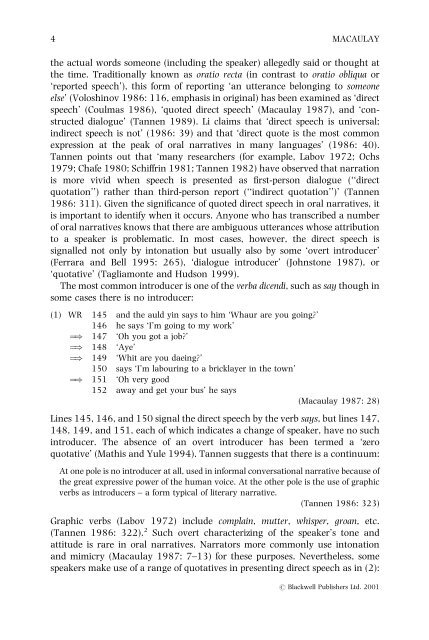You're like `why not?' The quotative expressions of Glasgow ...
You're like `why not?' The quotative expressions of Glasgow ...
You're like `why not?' The quotative expressions of Glasgow ...
Create successful ePaper yourself
Turn your PDF publications into a flip-book with our unique Google optimized e-Paper software.
4<br />
MACAULAY<br />
the actual words someone including the speaker) allegedly said or thought at<br />
the time. Traditionally known as oratio recta in contrast to oratio obliqua or<br />
`reported speech'), this form <strong>of</strong> reporting `an utterance belonging to someone<br />
else' Voloshinov 1986: 116, emphasis in original) has been examined as `direct<br />
speech' Coulmas 1986), `quoted direct speech' Macaulay 1987), and `constructed<br />
dialogue' Tannen 1989). Li claims that `direct speech is universal;<br />
indirect speech is <strong>not</strong>' 1986: 39) and that `direct quote is the most common<br />
expression at the peak <strong>of</strong> oral narratives in many languages' 1986: 40).<br />
Tannen points out that `many researchers for example, Labov 1972; Ochs<br />
1979; Chafe 1980; Schi€rin 1981; Tannen 1982) have observed that narration<br />
is more vivid when speech is presented as ®rst-person dialogue ``direct<br />
quotation'') rather than third-person report ``indirect quotation'')' Tannen<br />
1986: 311). Given the signi®cance <strong>of</strong> quoted direct speech in oral narratives, it<br />
is important to identify when it occurs. Anyone who has transcribed a number<br />
<strong>of</strong> oral narratives knows that there are ambiguous utterances whose attribution<br />
to a speaker is problematic. In most cases, however, the direct speech is<br />
signalled <strong>not</strong> only by intonation but usually also by some `overt introducer'<br />
Ferrara and Bell 1995: 265), `dialogue introducer' Johnstone 1987), or<br />
`<strong>quotative</strong>' Tagliamonte and Hudson 1999).<br />
<strong>The</strong> most common introducer is one <strong>of</strong> the verba dicendi, such as say though in<br />
some cases there is no introducer:<br />
1) WR 145 and the auld yin says to him `Whaur are you going?'<br />
146 he says `I'm going to my work'<br />
ˆ) 147 `Oh you got a job?'<br />
ˆ) 148 `Aye'<br />
ˆ) 149 `Whit are you daeing?'<br />
150 says `I'm labouring to a bricklayer in the town'<br />
ˆ) 151 `Oh very good<br />
152 away and get your bus' he says<br />
Macaulay 1987: 28)<br />
Lines 145, 146, and 150 signal the direct speech by the verb says, but lines 147,<br />
148, 149, and 151, each <strong>of</strong> which indicates a change <strong>of</strong> speaker, have no such<br />
introducer. <strong>The</strong> absence <strong>of</strong> an overt introducer has been termed a `zero<br />
<strong>quotative</strong>' Mathis and Yule 1994). Tannen suggests that there is a continuum:<br />
At one pole is no introducer at all, used in informal conversational narrative because <strong>of</strong><br />
the great expressive power <strong>of</strong> the human voice. At the other pole is the use <strong>of</strong> graphic<br />
verbs as introducers ± a form typical <strong>of</strong> literary narrative.<br />
Tannen 1986: 323)<br />
Graphic verbs Labov 1972) include complain, mutter, whisper, groan, etc.<br />
Tannen 1986: 322). 2 Such overt characterizing <strong>of</strong> the speaker's tone and<br />
attitude is rare in oral narratives. Narrators more commonly use intonation<br />
and mimicry Macaulay 1987: 7±13) for these purposes. Nevertheless, some<br />
speakers make use <strong>of</strong> a range <strong>of</strong> <strong>quotative</strong>s in presenting direct speech as in 2):<br />
# Blackwell Publishers Ltd. 2001
















